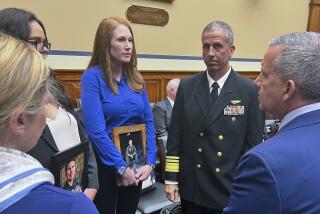Op-Ed: Saving the Warthog to save troop lives
- Share via
Reminiscing about his service in the Korean War, a veteran once remarked to me with wonder how his Army boots were so inadequate in the freezing conditions of winter combat that he and his comrades would compete for the fur-lined boots of dead Chinese soldiers and even mount dangerous trench raids for that purpose. “How was it,” he said, “that I, as a soldier of the richest nation on Earth, was having to steal the boots of soldiers from one of the poorest countries on Earth?”
The answer was not that the U.S. military was too underfunded to buy proper boots for its men. After all, the military budget shot up to World War II levels once the war started. It was because senior commanders preferred to spend the money elsewhere, mostly on a variety of strategic nuclear bombers and other aircraft that never reached Korea.
U.S. military footwear has improved since those days, but the overall mind-set has not changed, as glaringly demonstrated by the Air Force’s current efforts to junk the A-10 Warthog, the only aircraft specifically designed to support ground troops in combat. The plane is devastatingly effective in this role, thanks to its ability to maneuver close to the ground in the face of hostile fire while accurately targeting enemy positions with its lethal 30-millimeter cannon. Scores of combat veterans ascribe their survival in firefights to intervention by one or more A-10s, accolades accorded no other combat plane.
This simple fact of life cuts no ice with Air Force planners, traditionally disdainful of the close support mission, as they pursue a furious campaign to discard the A-10. They justify their plan with excuses, including that the plane is “40 years old and designed to fight Soviet tanks” and therefore obsolete. But they studiously ignore its vital contributions in every war since 1991.
Lacking experience in, or at least uncaring of, current combat realities, commanders tout multi-role substitutes, such as the B-1 bomber, which depend on video screens and map coordinates to place their bombs. Reliance on such means has left a trail of collateral damage across recent war zones, not only dead civilians by the score, but also U.S. service personnel. In June, a B-1 killed five American soldiers because the crew did not know that the plane’s technology could not detect markers for “friendlies.”
The campaign against the A-10 has been ongoing for decades but has taken on new urgency as the Air Force defends its treasured F-35 Joint Strike Fighter program. This gold-plated clunker, years late and staggeringly over budget, is today’s equivalent of the Korean War-era nuclear bombers that ate up all the boot money. Although the program is years behind schedule because of its shortcomings, the Air Force shamelessly claims that the principal obstacle to imminent deployment is a suddenly discovered shortage of mechanics that can be alleviated only by reassigning personnel from a junked A-10 program.
“Are we going to delay the Joint Strike Fighter?” Air Force Secretary Deborah Lee James said recently. “That would be awful. Are we going to underman the very aircraft that are most needed in this latest fight” against Islamic State?
The delay of which James complained in this fatuous statement (the F-35 will not even complete operational testing until 2019) has been brought about by congress. Impelled by well-informed arguments from combat veterans and the clear political logic of sticking up for the grunts on the ground, the House Armed Services Committee, as well as the full House and relevant Senate defense committees, voted overwhelmingly this year to prevent the Air Force from retiring the plane.
That should have been the end of it, but the service chiefs refuse to concede defeat. The Senate and House committee bills expressed the same intent but in different ways. The final 2015 defense authorization bill is therefore being negotiated behind closed doors by the committees’ leadership. It is here, secluded from public scrutiny, that the will of the wider Congress and the lives of soldiers may be ignored in favor of obliging the generals’ demands. The respective Armed Services Committee chairmen, Sen. Carl Levin (D-Mich.) and Rep. Howard “Buck” McKeon (R-Santa Clarita), have shown little interest in the case for the A-10. Rumors on Capitol Hill do not bode a good result.
Let us hope that common sense and simple humanity win the day.
Andrew Cockburn, Washington editor of Harper’s magazine, is the author of the forthcoming “Kill Chain: Drones and the Rise of the High-Tech Assassins.”
Follow the Opinion section on Twitter @latimesopinion
More to Read
A cure for the common opinion
Get thought-provoking perspectives with our weekly newsletter.
You may occasionally receive promotional content from the Los Angeles Times.






